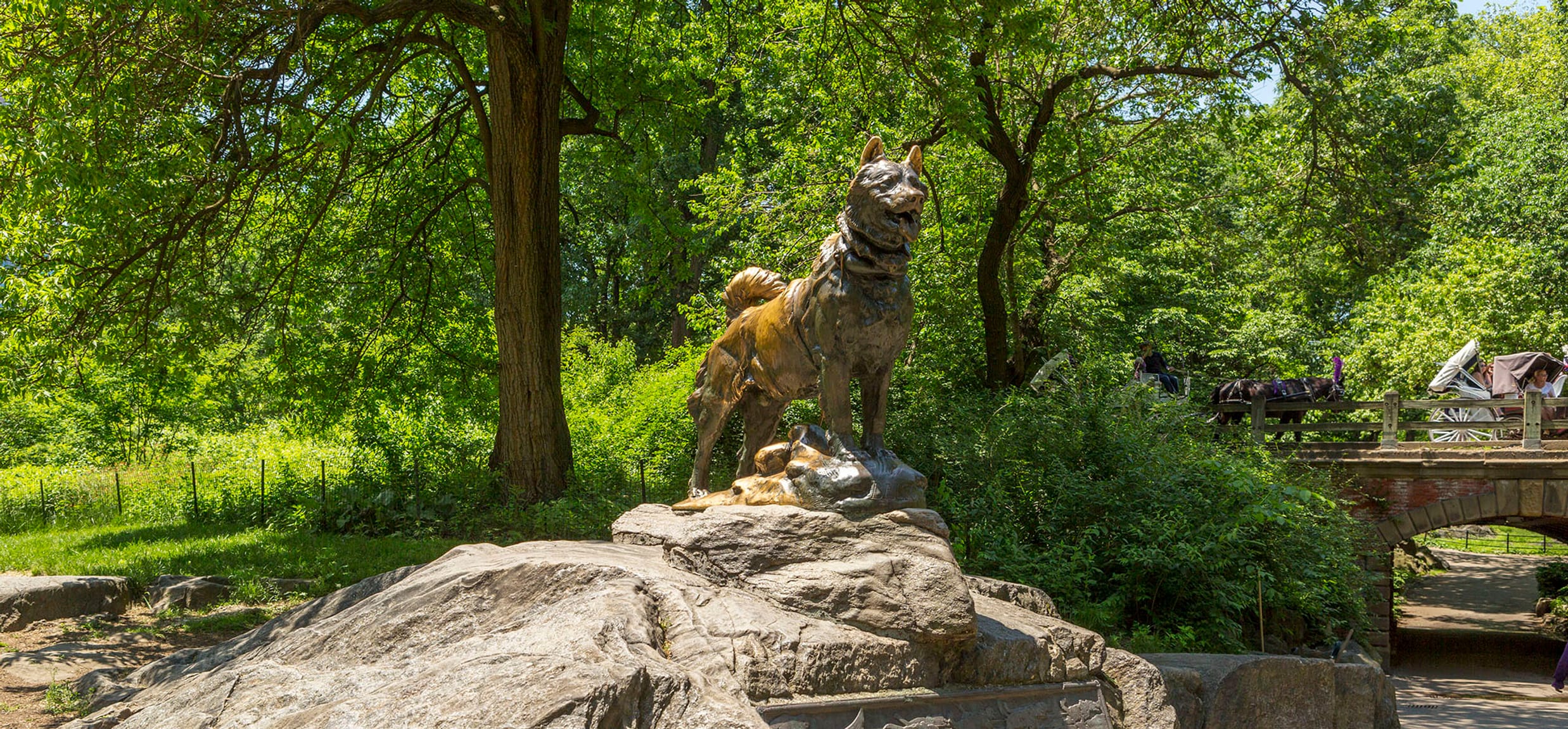Magazine
From Alaska to Central Park: Balto the Siberian Husky

Central Park is home to an important collection of more than 50 sculptures and monuments—out of 70 artworks—with many of them commemorating famous figures or historical events. Arguably the most popular statue in the Park is of Balto, the famed Alaskan sled dog that battled blizzard conditions to deliver medicine to children in Nome, Alaska.
Like many statues in the Park, this bronze sculpture has a fascinating background story. Discover the captivating past, present, and future of Balto, from its dedication (did you know Balto himself was present?) to our work to preserve the statue for the future.

Balto (East Drive at 67th Street) commemorates the Siberian husky that delivered medicine to children in Alaska during a diphtheria epidemic.
The history of Balto
In January 1925, a deadly diphtheria epidemic threatened the children of Nome, Alaska. Medicine to stop the outbreak was in Anchorage, nearly 700 miles away. Twenty sled dog teams relayed the medicine from Nenana to Nome, by way of the Iditarod Trail, in just over five days. They endured blinding snow and temperatures reaching 50 degrees below zero.
Balto, a hardy Siberian husky, led the final leg of the trip with his musher, Gunnar Kaasen, and a team of dogs. They entered Nome just before daybreak on February 2, 1925.
People followed the race around the globe through newspapers and radio, and Balto became a worldwide sensation. A group of New York City artists, led by Cecilia Beaux, felt strongly that he should be commemorated in Central Park, so they raised the funds to create his statue. Sculpted by Frederick Roth, Balto was erected on an outcropping in the Park on December 17, 1925. Balto and Kaasen were present for the monument’s unveiling, making this statue the only effigy in the Park with the honoree present at the unveiling.

The plaque under Balto's statue highlights the “indomitable spirit” of Balto and other sled dogs.
Balto passed away in 1933, and he is now stuffed and mounted at the Cleveland Museum of Natural History. His legacy was honored in the 1995 animated film Balto, which features live action scenes in Central Park.
Caring for sculptures
To keep statues like Balto looking their best year-round, the Conservancy has a team of monument conservators who regularly take care of the Park’s statues. On any given day, dozens of children climb and pose for photos on Balto, which over time has become an interactive work of art. The Conservancy’s annual maintenance treatment for the statue consists of replenishing its hot wax coating, which protects it from the elements.

The Conservancy restores Balto's protective coating of hot wax each year.
Because Balto is so popular as a climbing sculpture, it is susceptible to more wear than other sculptures in the Park. To ensure that Balto and statues like it are protected, our conservators have adopted an additional preservation strategy: three-dimensional scanning.
Last summer, we worked with a company specializing in 3D scanning to document every detail of Balto and Alice in Wonderland, another popular children’s statue in the Park, in case they need to be repaired or replicated in the future. Three-dimensional scanning creates a permanent digital archive, serving as an important tool for the long-term preservation of these sculptures.

With these 3D scans of Balto, every detail of the statue is now documented.
How does this process work? Three-dimensional scanners project light (in the form of lasers, white light, structured light, and in some cases, infrared light) onto surfaces. The light gets reflected back and captured by the scanner. The data collected is used to create a 3D model of the sculptures.
In the coming years, we’ll also perform 3D scans of Bethesda Fountain and Burnett Fountain.
The significance of Balto and other statues
Balto continues to be a beloved sculpture for kids and adults alike. The creator of Balto also made other treasured sculptures throughout the Park—Mother Goose, Honey Bear, Dancing Goat, and the Sophie Loeb Fountain, which depicts scenes from Alice in Wonderland, in the James Michael Levin Playground. Roth also created limestone reliefs in the Central Park Zoo that depict antelopes, birds, monkeys, and other animals.
Like Balto, various statues in Central Park commemorate major events, people, and/or periods in American history. In addition, many Park statues represent some of the most important sculptors and stylistic movements of the 19th and 20th centuries. The Conservancy provides the thoughtful care that Park statues require, so that they continue to benefit those who enjoy them now, and those who will enjoy and learn from them in the decades to come.
Balto is endowed by Karen and Richard LeFrak. The scanning of Balto and Alice in Wonderland was generously funded by American Express.



